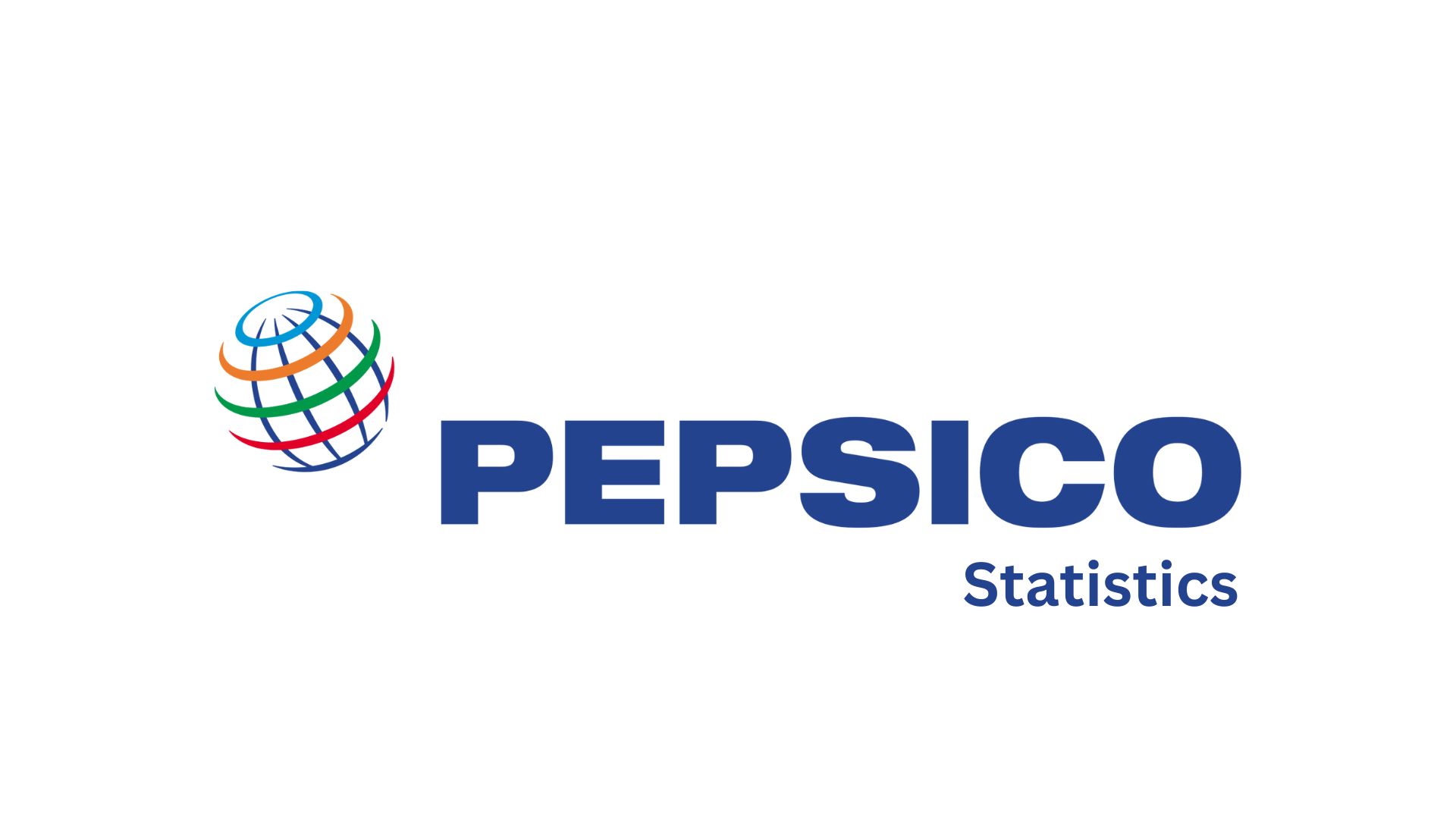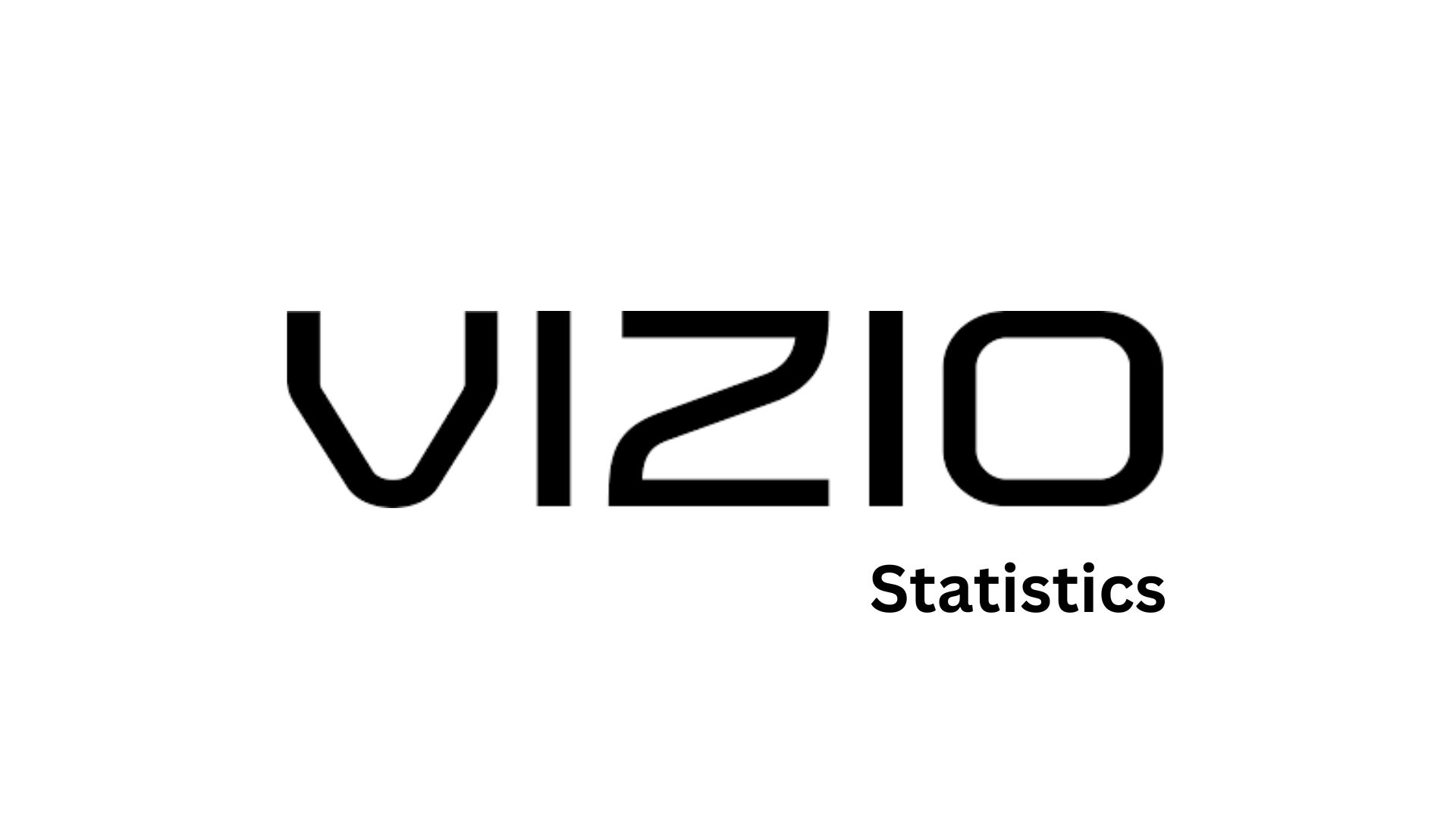Performance Management Statistics By Productivity, Technology And Trends (2025)

Updated · Jul 29, 2025


WHAT WE HAVE ON THIS PAGE
- Introduction
- Editor’s Choice
- Historical Evolution of Performance Management Statistics
- Business Impact and Competitive Advantage of Performance Management Statistics
- Feedback Frequency and Performance Review Cadence Statistics
- Engagement, Retention and Productivity Metrics in Performance Management Statistics
- Technology, AI Use and Effectiveness in Performance Management Statistics
- Leadership and Coaching Impact in Performance Management Statistics
- 360 Degree Feedback Statistics in Performance Management
- Recognition and Rewards Metrics in Performance Management Statistics
- Diversity, Inclusion and Performance Management Statistics
- Burnout, Well‑being and Performance Management Statistics
- Remote and Hybrid Team Performance Management Statistics
- Onboarding and Succession Planning Statistics in Performance Management
- Performance Improvement Plans (PIP) and Underperformance Stats
- Learning and Development (L&D) Effectiveness Statistics
- Future Trends and Predictions for Performance Management Statistics
- Conclusion
Introduction
Performance Management Statistics: Performance management has evolved significantly beyond traditional annual reviews and ratings. That’s why I wanted to break down some of the most important and up-to-date performance management statistics, so you can see exactly how organizations are improving productivity, employee engagement, and overall business success.
In this article, I’ll walk you through the evolution of performance management, what the numbers reveal about modern practices, and the trends shaping the future. Whether you’re in HR, leading a team, or just curious about how this works behind the scenes, this guide is packed with insights that are easy to understand, even if you’re new to the topic. Let’s explore the stats that matter, and why they should matter to you. Let’s get into it.
Editor’s Choice
- According to Gallup, companies that give continuous feedback see a 50% higher employee performance compared to those with annual reviews.
- A report from Officevibe shows that 96% of employees believe regular feedback improves their performance. However, only 14% say their managers give timely feedback.
- According to McKinsey, companies with engaged employees outperform others by 202% in business outcomes.
- Gallup found that managers influence 70% of how engaged an employee feels. So, performance reviews are not just about numbers but also about how good your manager is.
- Companies with weekly feedback systems report 21% higher profitability and 24% lower turnover, according to a Bersin by Deloitte study.
- According to SHRM, losing a skilled employee costs a company about 150 to 200% of that person’s annual salary.
- Harvard Business Review reported that companies using goal-setting software saw a 20 to 25% productivity increase in just one year.
- Gartner says 46% of HR managers now use AI tools for performance reviews. These tools track goals, give feedback, and even suggest training paths using data.
- A Deloitte survey shows that 82% of companies are redesigning performance management to be more ongoing, data-driven, and personalized.
- LinkedIn’s 2024 Workplace Report says 94% of employees would stay longer at a company that invests in their career.
- PwC found that 60% of businesses are now investing in AI-powered performance tools. These tools help identify top performers faster and personalize coaching.
- Research from Gallup shows engaged teams have 41% lower absenteeism and 17% higher productivity.
- A study by CultureAmp reveals that only 18% of employees feel traditional performance reviews are fair.
- Mercer found that 78% of organizations plan to redesign their performance management in the next 2 years.
- IBM research shows that an AI-enabled review system improves employee trust and transparency by 32%. Employees feel more fairly treated when tech removes bias.
| Key Area | Insight |
| Feedback Frequency |
96% say regular feedback improved performance |
|
Manager Impact |
70% of engagement depends on the manager |
| Profitability |
Weekly reviews are equal to 21% higher profits, 24% lower turnover |
|
Engagement |
Engaged teams equal 202% higher performance |
| Retention |
94% stay longer if career growth is supported |
|
Cost of Turnover |
Losing one employee is equivalent to up to 200% of their salary |
| Digital Tools |
20 to 25% productivity boost via goal-setting apps |
|
AI in HR |
46% of HR teams use AI for reviews |
| Future of Reviews |
82% redesigning systems; annual reviews are outdated |
|
Transparency & Fairness |
AI systems improve trust by 32% |
| Absenteeism Reduction |
Engaged teams equal 41% less absenteeism |
|
Review Fairness |
Only 18% feel traditional reviews are fair |
| Redesign Plans |
78% of companies plan new review models |
|
Employee Motivation |
17% more productivity in engaged teams |
| Use of AI |
60% of companies are investing in AI for performance tracking |
Historical Evolution of Performance Management Statistics
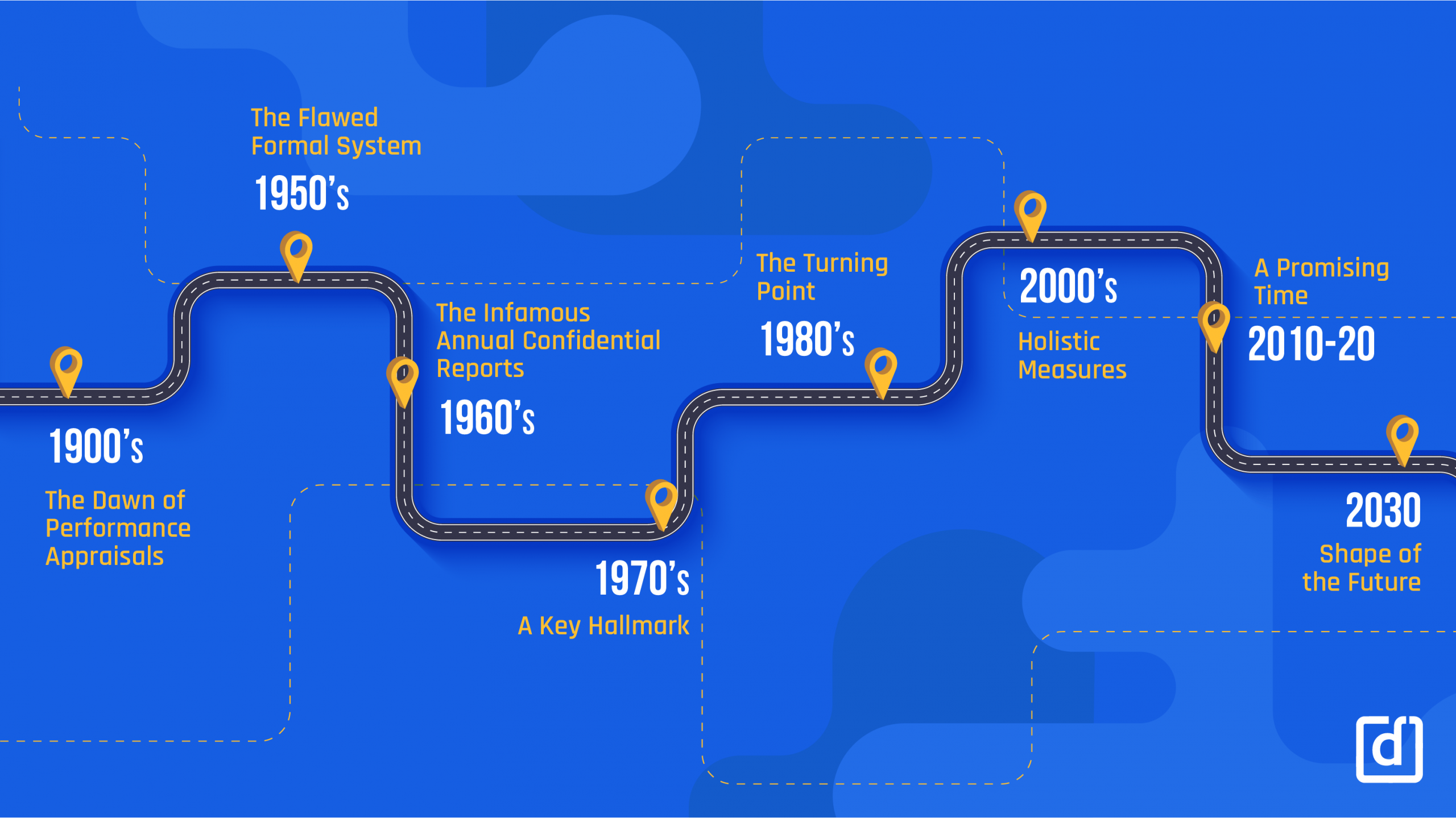
- In the 1950s, 60% of US firms used annual performance appraisals, marking the formalization of performance measurement.
- In the 1980s, 90% of firms adopted rating scales, with forced ranking rising to a peak usage of 33% by 2006.
- Balanced Scorecard, a strategic performance framework, was introduced in 1992 and adopted by over 50% of Fortune 500 companies by 2005.
- The rise of 360-degree feedback in the 1990s saw 85% of Fortune 500 companies integrating multi-rater feedback by 2010.
- The early 2000s brought multiple check-ins; yet annual reviews remained dominant with 70%+ usage until the 2010s.
- Cloud-based performance platforms emerged around 2010, growing to 65% adoption among new implementations in 2025.
- AI tools started appearing in performance systems around 2018, expanding from 5% adoption to 52% by 2025.
- In the 2020s, the trend shifted decisively to continuous feedback, with 48% of companies planning full adoption by 2028.
| Historical Era | Key Performance Management Milestone |
| The 1950s: Annual appraisals inception |
60% usage |
|
1980s to 2000s: Forced ranking surge |
Peaked at 33% adoption |
| 1990s to 2005: Balanced Scorecard uptake |
50% of Fortune 500 |
|
The 1990s to 2010: 360-feedback growth |
85% integration among top firms |
| 2000s to 2010s: Annual reviews inertia |
70%+ usage until modern shifts |
|
2010s to 2025: Cloud platform rise |
65% adoption in new implementations |
| 2018 to 2025: AI adoption surge |
5% 52% usage growth |
|
2020s: Continuous feedback trend |
48% planning full adoption by 2028 |
| Mid‑2020s: DEI/ESG integration |
Values now part of performance metrics |
|
Today: Insight‑driven and ethical focus |
Shift from evaluation to development |
Business Impact and Competitive Advantage of Performance Management Statistics
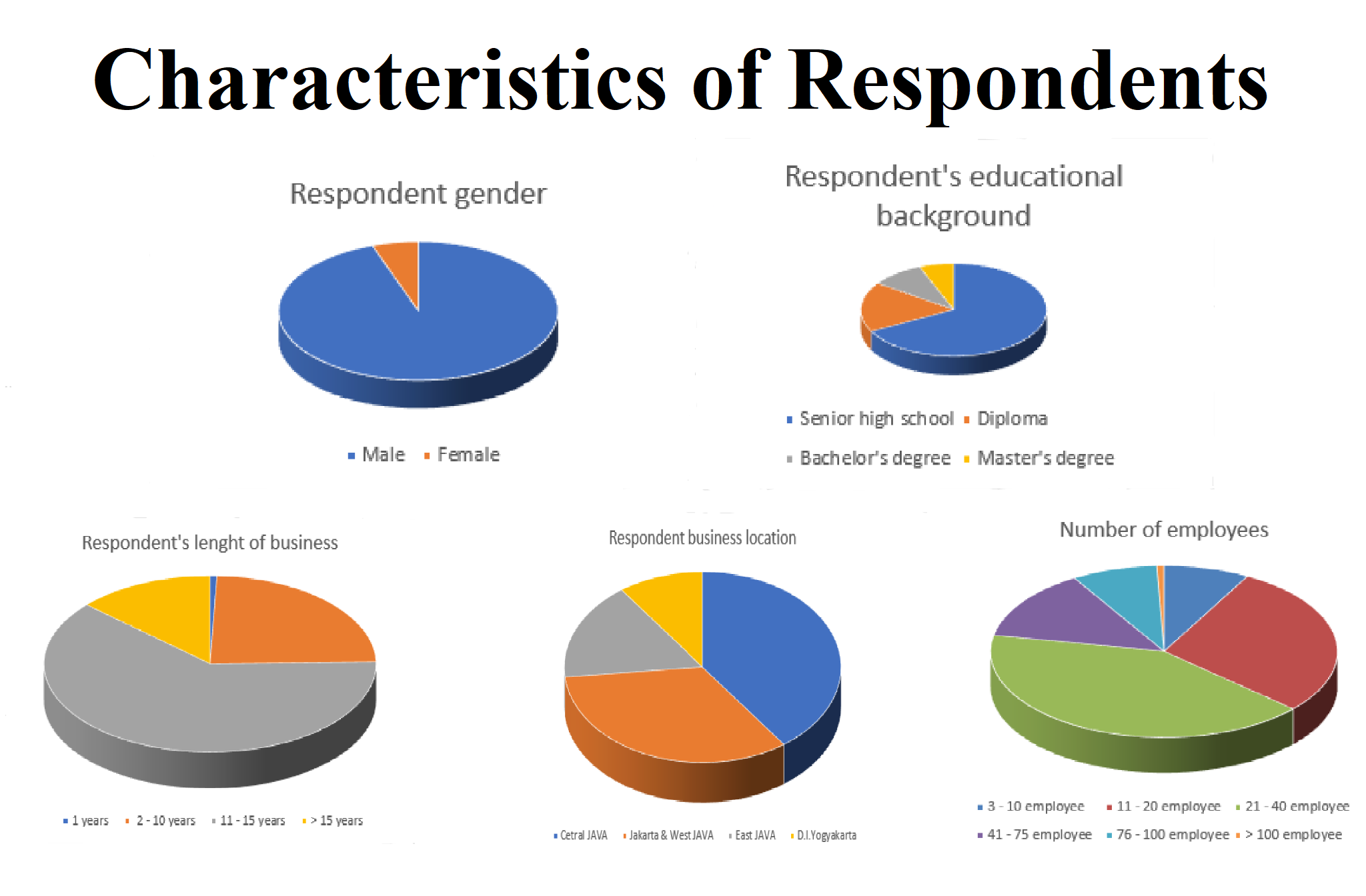
- Companies that prioritize performance management are 4.2x more likely to financially outperform industry peers.
- Employees with well-defined performance expectations report 69% greater engagement, directly affecting productivity.
- Organizations with structured performance systems experience up to a 25% reduction in turnover, improving retention.
- Regular feedback cycles boost team productivity by approximately 21%, enhancing operational responsiveness.
- Businesses using SMART goals see 24 to 33% improvements in goal achievement and alignment metrics.
- High-performing organizations report 27% higher earnings and 38% greater productivity versus low-performing peers.
- Nearly 83 to 91% of business leaders believe effective performance management is essential for organizational success.
- Only about 32% of companies say their approach enables timely, high-quality decisions on talent.
- Companies investing in performance technology are 2.5x more likely to track performance analytics effectively.
- Continuous feedback systems deliver 39% better talent attraction and 44% improved retention versus annual reviews.
| Metric | Stats Summary |
| Outperformance likelihood | 4.2x more likely |
| Employee engagement increases | +69% |
| Turnover reduction impact | -25% |
| Productivity gain via feedback | +21% |
| Goal achievement via SMART frameworks | +24 to 33% |
| Earnings & productivity uplift | +27% earnings, +38% productivity |
| Leadership valuation | 83 to 91% see as essential |
| Talent decisions agility | Only 32% enable timely decisions |
| Analytic adoption impact | 2.5x higher tracking probability |
| Talent attraction & retention improvement | +39% attraction, +44% retention |
Feedback Frequency and Performance Review Cadence Statistics
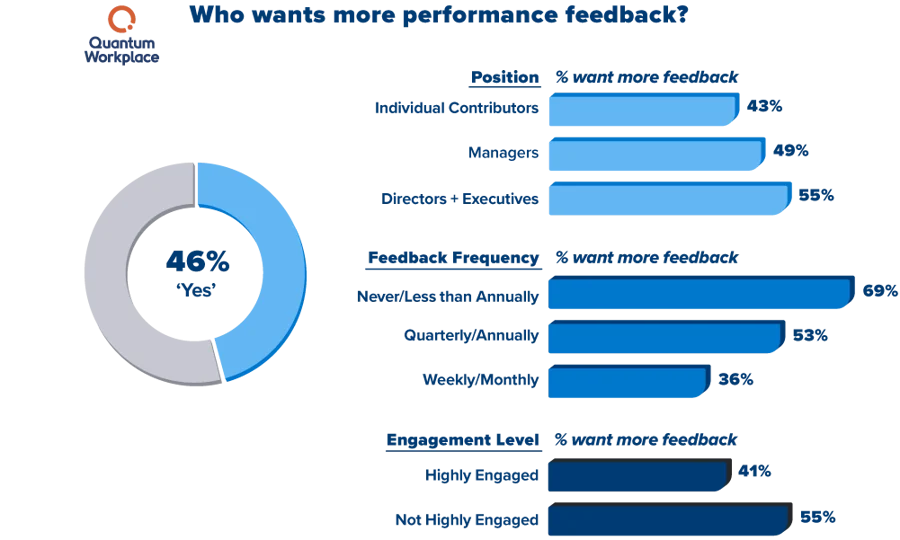
- About 63 to 71% of organizations still rely on annual or bi-annual reviews instead of ongoing feedback.
- Nearly 19% of employees receive feedback just once a year, hindering timely course correction.
- Only 41% of firms have shifted to frequent one-on-one check-ins, leaving 59% stuck in legacy systems.
- Workers reporting feedback weekly are 5.2x more likely to experience meaningful performance guidance.
- Employees receiving quarterly or monthly reviews are 4× more likely to feel supported. Regular signals of performance reduce ambiguity and anxiety.
- A full 80% of employees prefer real‑time, ongoing feedback compared to annual-only reviews. Employees seek responsiveness and recognition in the flow of work.
- Only 5% of HR leaders say they are satisfied with traditional review systems in place. The high dissatisfaction reflects outdated approaches and low impact.
- Less than 35% of employees believe current appraisal systems reflect their actual contributions.
- Managers spend, on average, 210 hours per year per team preparing traditional appraisals. Time investment is high, yet remains disconnected from day-to-day realities.
- Continuous feedback systems correlate with 2× higher employee performance compared to annual review users.
| Cadence Metric | Performance Management Statistics Summary |
| Reliance on annual reviews | 63 to 71% of organizations |
| Employees with yearly feedback | 19% |
| Frequent one‑on‑one adoption | Only 41% shifted |
| Feedback impact likelihood (weekly) | 5.2× more meaningful guidance |
| Supportive review perception (quarterly) | 4× more likely |
| Employee preference for feedback | 80% want real-time |
| HR satisfaction with traditional systems | 5% only |
| Contribution accuracy belief | <35% employees feel appraisals reflect real work |
| Manager’s time spent on reviews | 210 hours/year per team |
| Performance increase via continuous models | 2× higher performance |
Engagement, Retention and Productivity Metrics in Performance Management Statistics
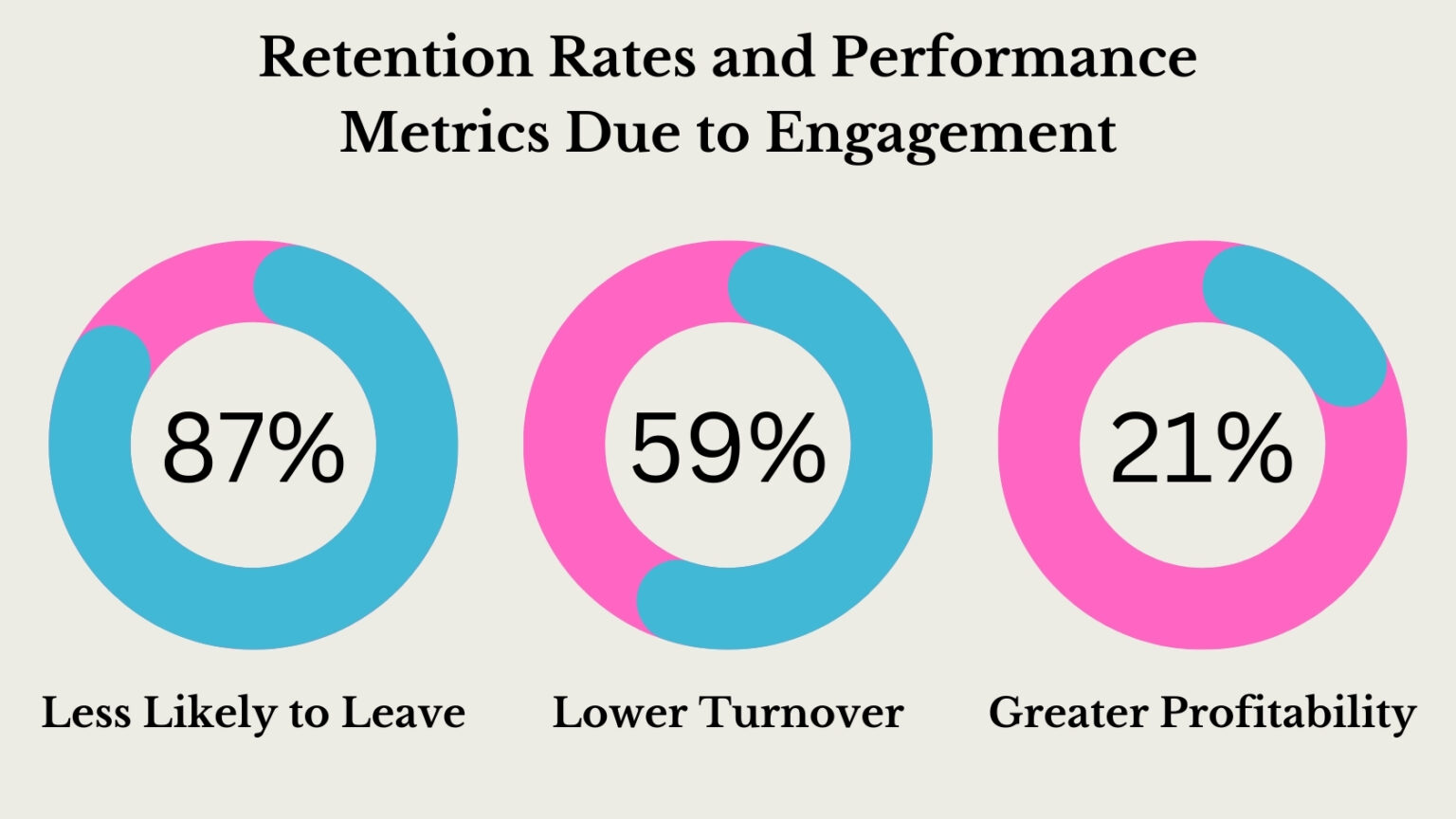
- Disengaged employees cost economies about $8.8 to $8.9 trillion annually, nearly 9% of global GDP.
- Highly committed employees are 20% more productive and 87% less likely to quit their jobs. Commitment drives loyalty and significantly higher output.
- Organizations using high‑involvement management practices outperform peers by 47% to 200%.
- Firms with high engagement increase sales per square foot by 10% and operating income by 36%.
- Employees who feel unrecognized are 31% more likely to voluntarily leave their employer. Recognition plays a huge role in retention and long-term satisfaction.
- Feedback cultures that prioritize appreciation reduce turnover by 25 to 34%. Positive reinforcement significantly steadies headcount.
- About 85% of employees report higher productivity when recognition is clear and timely. Appreciation drives motivation, performance, and discretionary effort.
- Organizations with strong engagement report 86% healthy peer relationships, compared to just 45% among disengaged groups.
- In culture‑focused firms, average turnover is 13.9%, versus 48.4% where culture is weak. Cultural investment yields retention and organizational stability.
- High‑performing companies are 21% more profitable when managers frequently coach and communicate.
| Engagement Metric | Performance Management Statistics Summary |
| Global cost of disengagement | $8.8 to $ 8.9 trillion/year |
| Productivity & retention gains | +20% productivity / to 87% attrition |
| High-involvement performance uplift | +47 to 200% performance advantage |
| Retail financial impact | +10% sales / +36% op income |
| Lack of recognition attrition likelihood | +31% more likely to leave |
| Retention via feedback culture | Turnover reduced by 25 to 34% |
| Productivity with recognition | 85% employees are more productive when appreciated and build |
| Peer relationship health | 86% in engaged vs 45% in disengaged |
| Culture and turnover | 13.9% vs 48.4% |
| Manager coaching effect | +21% profitability |
Technology, AI Use and Effectiveness in Performance Management Statistics
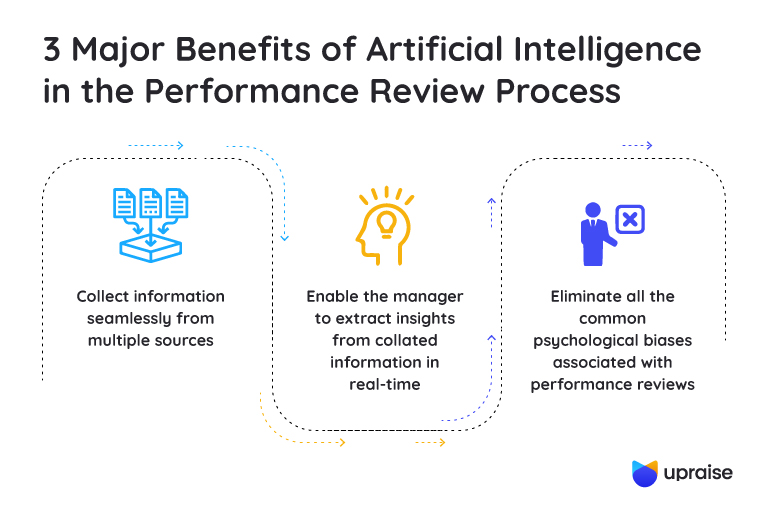
- Around 87 to 92% of organizations now use software to monitor performance, up sharply in recent years.
- AI‑driven performance tools reduce bias by 30% and lift evaluation accuracy significantly. They help remove subjective distortions, creating fairer outcomes for all workers.
- Roughly 52% of managers use AI tools in appraisals or coaching workflows today.
Adoption continues to rise as familiarity and trust grow. - AI-powered systems yield 71% higher engagement, 50% better goal achievement, and 33% less bias.
- Approximately 60 to 65% of enterprises are using cloud-based performance platforms in 2025. Cloud solutions offer scalability, real-time access, and flexible deployment features.
- Only 47% of HR leaders say they are ready for future performance needs supported by digital tools. A readiness gap persists despite adoption.
- Companies using performance analytics are 2.5× more likely to track and elevate high performers. Data-driven tracking enhances identification and retention of top talent.
- Teams that implement performance tech report a 12% boost in customer satisfaction metrics. Improved internal performance translates to better client outcomes.
- Just 42% of firms utilize performance tools extensively, indicating widespread underutilization. Many organizations have tools but lack integrated, regular use.
- HR respondents say 70% of employees see coaching and feedback tech as improving performance. Digital systems support stronger interactions and performance clarity.
| Tech and AI Metric | Performance Management Statistics Summary |
| Software usage by organizations | 87 to 92% using tools |
| Bias reduction via AI | 30% bias; improved accuracy |
| Manager adoption of AI | 52% managers use AI |
| AI impact on engagement, goals, and bias | +71% eng / +50% goals / to 33% bias |
| Cloud platform adoption rate | 60 to 65% enterprises are adopting |
| HR readiness for digital transition | Only 47% feel prepared |
| Analytics adoption boost | 2.5× more likely to track high performers |
| Customer satisfaction improvement | +12% when tech is used |
| Extensiveness of tool use | Only 42% use them deeply |
| Employee perception of feedback tech |
70% feel it enhances performance |
Leadership and Coaching Impact in Performance Management Statistics
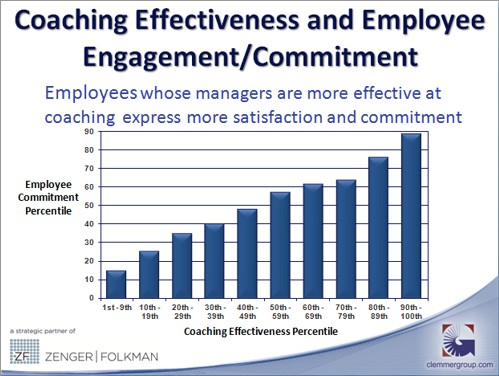
- Leadership training programs boost business performance by 25% while increasing overall job performance by 20%, providing direct ROI in team output.
- Participants also saw a 28% rise in leadership behaviors and an 8% increase in direct report results.
- Executive coaching is now the third most sought-after service among business students, strengthening leadership capabilities across sectors. It’s enhancing reflection, communication skills, and job performance among upcoming leaders in global firms.
- The global coaching market is currently valued at $6.25 billion, projected to reach $7.30 billion by 2025, with 145,500 active coaches expected to rise to 167,300 by next year.
- Sustained 17% CAGR (2019 to 22) and a 13.9% growth outlook through 2034 confirm long-term demand.
- A study combining GenAI with traditional coaching found that AI tools are mainly used for administrative support and research, with coaches emphasizing the importance of AI literacy and ethical use.
- AI-driven “task-time” coaching systems like Socratic have demonstrated measurable performance gains in real-time teamwork scenarios, validating technology-aided interventions.
- Public sector managers using executive coaching saw an 88% boost in productivity, highlighting strong returns even outside private sector contexts.
- Only 44% of managers have received formal training, and trust in managers declined from 46% to 29% between 2022 to 24, indicating an urgent need for coaching and development.
- Companies with strong leadership development report 25% stronger business results, showing a correlation between internal capability building and organizational success.
- New research shows coaching-centric companies enjoy 22% higher employee engagement, their teams are 18% more engaged, with 12% more productivity, plus turnover falling by 28%.
- Shared leadership models, where decision-making is distributed, have proven to positively predict team effectiveness and confidence, outperforming traditional hierarchical leadership.
| Leadership and Coaching Metric | Performance Management Statistics Summary |
| Business performance uplift via training | +25% business, +20% job performance |
| Leadership behavior and results | +28% leadership behaviors, +8% direct report performance |
| Coaching market scale (2024 to 25) | $6.25 B $7.30 B, 145.5 K 167.3 K coaches |
| Coaching CAGR (2019 to 22) | 17% annual growth |
| Executive coaching popularity | The 3 most desired among business students |
| GenAI coaching adoption | Gains in admin efficiency, emphasis on AI literacy |
| Real-time AI coaching effectiveness | Improved high-stakes team performance |
| Public-sector coaching performance gain | +88% productivity |
| Leadership trust and training gap | Trust dropped 46→29%, training coverage 44% |
| Engagement & productivity via coaching | +22% employee engagement, +12% productivity, −28% turnover |
| Shared leadership impact | Predicts team performance, confidence |
360 Degree Feedback Statistics in Performance Management
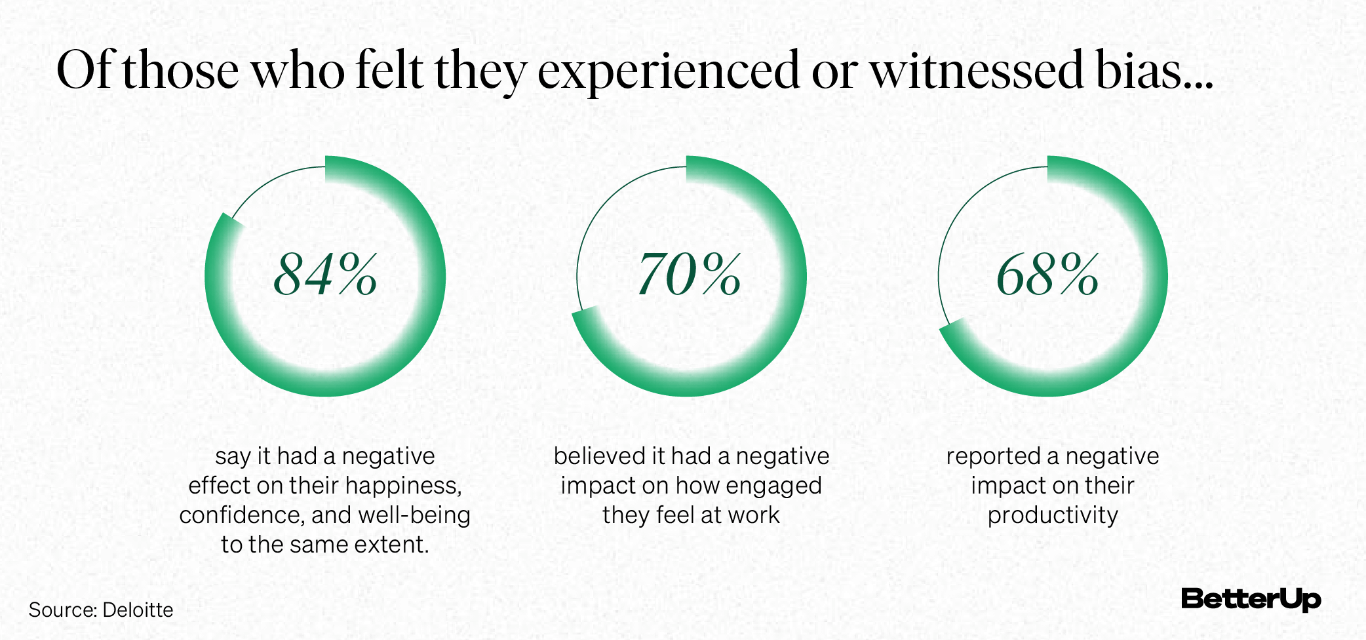
- Organizations implementing 360-degree feedback systems report a 10% improvement in overall performance through enhanced self-awareness and leadership insight.
- More than 85% of Fortune 500 companies now use this feedback to shape leadership development.
- A Gallup survey found that only 14% of employees strongly believe reviews motivate improved performance, while 77% of HR leaders see appraisals as inaccurate.
- DecisionWise studies show 360 scores don’t always correlate with KPI performance; managers hitting targets may still have low peer ratings.
- The “performance lag cycle” from behavior to measurable results spans about one year, emphasizing early detection via multi-rater feedback.
- In healthcare and public sectors, 360 feedback reliably predicts team engagement and future operational success, but only if follow-up and coaching are consistent.
- Up to 90% of Fortune 500 firms like Netflix and GE use 360-degree feedback, underlining its entrenched role in senior development.
- However, most 360 users report issues: SHRM found the majority view feedback as biased or unhelpful.
- Financial Times reports banks manipulating reviewer selection and using anonymous feedback to game results during annual 360 cycles.
- Standalone 360 systems, updated annually, may have a low impact; studies show that only 30% of feedback cycles improved performance, and another 30% saw a decline.
- When combined with coaching, 360 feedback improves retention by 15.9% and boosts managerial effectiveness by up to 60%.
| 360° Feedback Metric | Performance Management Statistics Summary |
| Overall performance improvement | +10% via enhanced self-awareness |
| Fortune 500 adoption rate | 85 to 90% of firms |
| Employee trust in appraisals | Only 14% feel motivated, 77% HR see inaccuracy |
| KPI vs 360 correlation | Often mismatch; predicts lagging engagement |
| Performance lag cycle | 1 year |
| Sector use & outcome clarity | Effective with proper follow-up |
| Employee perception of bias | The majority view is biased/unhelpful |
| Misuse in banking | Process manipulation reported |
| Standalone cycle effectiveness | Only 30% show gains; 30% see decline |
| Combined with coaching impact |
+15.9% retention, +60% leadership effectiveness |
Recognition and Rewards Metrics in Performance Management Statistics
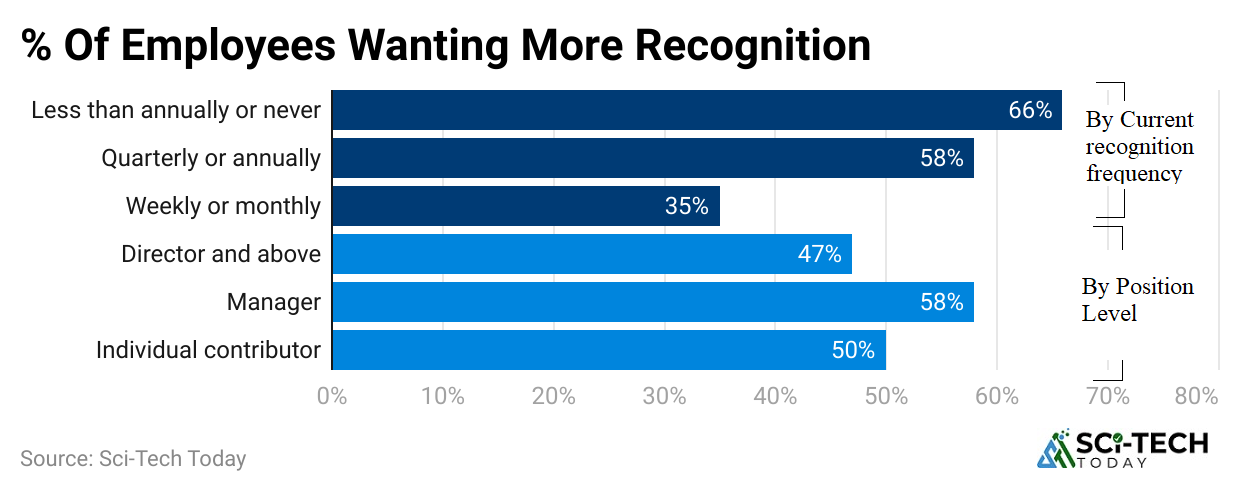
- Employees whose managers consistently acknowledge them for good work are 5× more likely to stay with the company.
- Recognition programs lower voluntary turnover rates by 31%, improving long‑term workforce stability.
- Manager-driven recognition increases employee engagement by 43%, creating momentum for performance.
- Companies that prioritize recognition report a 14 to 21% boost in productivity, a clear ROI.
From individual contributors to teams, recognized work spurs creativity and focus. Some studies even show recognition yields gains of over 21% in efficiency. - Fair recognition makes employees 4× more likely to feel engaged, far beyond monetary rewards alone.
- Employees recognized at least monthly are 2× more likely to feel productive and committed. Regular acknowledgment reinforces performance behaviors and sustains momentum.
- Just 40% of employees say they receive consistent recognition, indicating a large gap. Infrequent or uneven praise undermines motivation and trust in leadership.
- 50% of employees cite a lack of appreciation as a key reason for quitting their jobs. Even competitive salaries can’t compensate for a failed emotional connection. Recognition emerges as a core driver of retention and satisfaction.
- Organizations with recognition programs see 27% lower absenteeism and reduced shrinkage. Appreciated employees take fewer sick days and are more careful in their roles. These improvements benefit workplace well‑being and bottom‑line productivity.
- Employees who receive strong recognition are 33% more likely to be proactive and innovative. Feeling appreciated fosters initiative and creative problem-solving. Organizations benefit from more ideas and higher adaptability.
| Recognition Metric | Performance Management Statistics Summary |
| Manager recognition impact on retention | 5× more likely to stay |
| Program impact on turnover | 31% voluntary turnover |
| Engagement lift via manager praise | +43% |
| Productivity boost from recognition | +14 to 21% |
| Engagement via fairness | 4× more likely |
| Monthly recognition benefit | 2× productivity and commitment |
| Frequency gap in recognition | Only 40% receive recognition consistently |
| Appraisal factor for quitting | 50% leave due to a lack of appreciation |
| Absenteeism & shrinkage reduction | 27% via recognition programs |
| Innovation and proactiveness | +33% likelihood |
Diversity, Inclusion and Performance Management Statistics

- Companies with more ethnically diverse executive teams are 33% more likely to outperform peers on profitability. Diversity at the top level correlates strongly with better financial returns.
- Organizations ranking in the top quartile for gender diversity see 21% higher performance. Gender-balanced leadership drives stronger decision-making and growth. These companies often outperform their industry median annually.
- Workforces marked by inclusion are 1.4× more likely to report higher engagement. Inclusive cultures make employees feel seen, valued, and motivated to deliver. Engagement improves retention and lowers absenteeism rates.
- Diverse teams make better decisions 87% of the time, improving strategic outcomes. Varied viewpoints lead to more robust problem-solving and innovation. Decision reliability increases significantly in inclusive teams.
- Companies in the top diversity quartile are 3.8× more likely to be change-ready. Organic adaptability stems from a variety of perspectives and agility. Inclusion enables faster pivots in dynamic markets.
- Diverse teams are 1.7× more likely to be innovation leaders in their industry. Representation across demographics unlocks new ideas and creativity. This advantage grows with explicit inclusion strategies.
- Inclusion-focused companies retain employees 35% longer than those with weaker cultures. Belonging reduces turnover and builds deeper commitment over time.
- Gender-diverse teams achieve better results 15% faster compared to homogeneous groups.
Diversity accelerates insight, collaboration, and execution speed. - Companies with high ethnic diversity generate 2.3× more cash flow per employee. Financial benefits extend beyond innovation, directly affecting margins.
- Teams led by inclusive leaders are 17% more likely to report being high-performing. Leadership behaviors that value inclusion foster team excellence.
| Inclusion Metric | Performance Management Statistics Summary |
| Executive diversity profitability uplift | +33% |
| Gender diversity’s impact on performance | +21% |
| Engagement likelihood in inclusive cultures | 1.4× higher engagement |
| Decision-making effectiveness | Decisions are better 87% of the time |
| Change readiness | 3.8× more likely to be agile |
| Innovation leadership probability | 1.7× more likely |
| Employee retention boost via inclusion | +35% |
| Speed of results from gender-diverse teams | +15% faster |
| Cash flow per employee in diverse firms | 2.3× higher |
| High performance chances with inclusive leaders | +17% higher |
Burnout, Well‑being and Performance Management Statistics
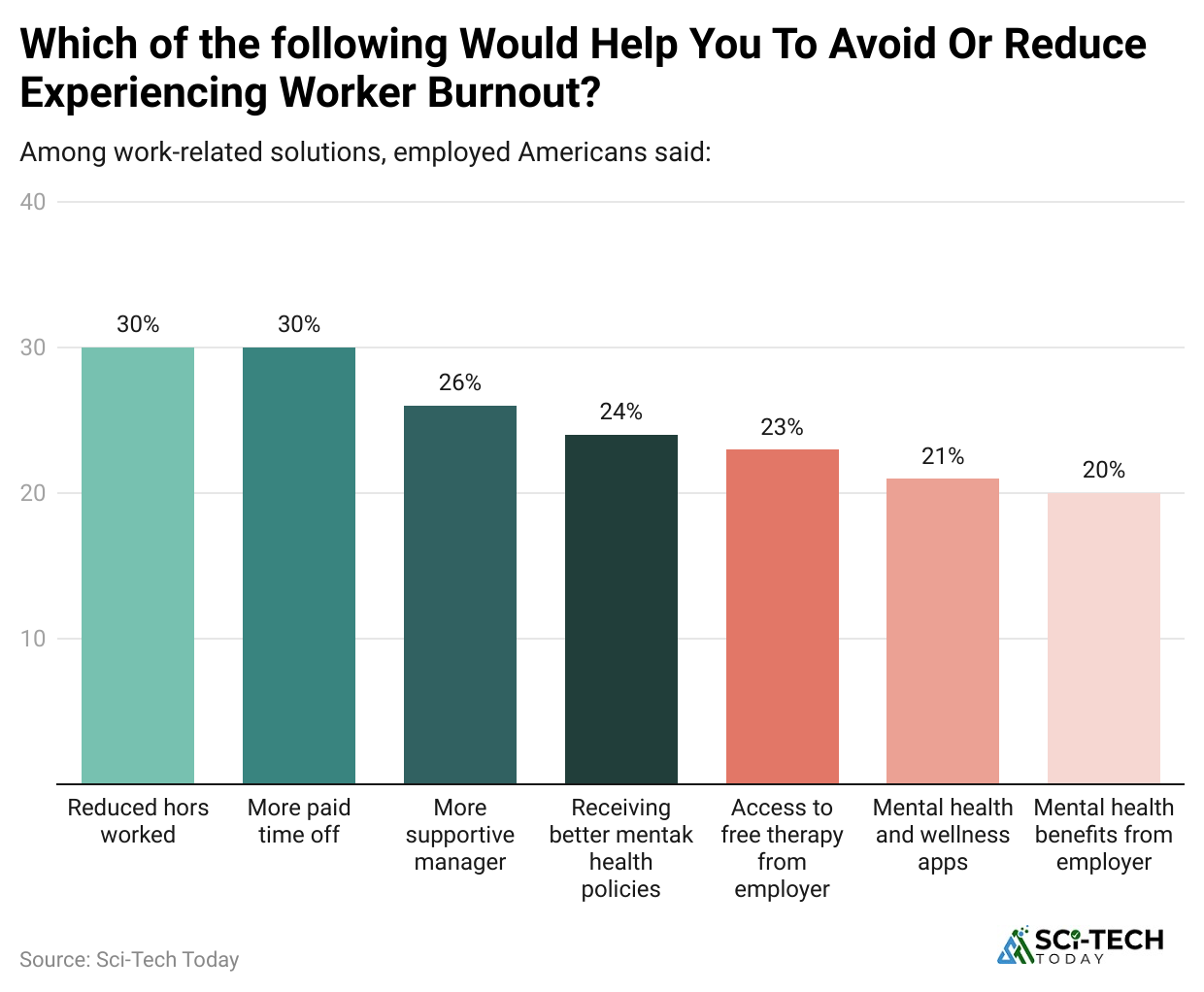
- A staggering 85% of workers report symptoms of burnout and exhaustion, often taking mental health leave.
- Nearly half of them take time off for recovery, 37% citing mental health reasons. Burnout erodes performance and damages team resilience.
- Among Gen Z and millennials, burnout affects 68% and 61% respectively, driving attrition considerations.
- Untreated mental health problems cost businesses $1 trillion globally in lost working days each year.
- Depression and anxiety account for an estimated 12 billion lost workdays globally. Productivity and retention deteriorate when mental health is ignored.
- .A 4-day workweek trial showed the same or higher productivity while significantly reducing burnout.
- A poor psychosocial safety climate (PSC) triples the risk of depressive symptoms at work. Improvements in PSC yield measurable performance benefits: 4% less burnout, 6% more engagement. Companies save thousands in reduced absenteeism and presenteeism.
- Eliminating low PSC environments could cut sick leave by 43% and presenteeism by 72%. In tech or high-pressure sectors, psychological safety has a measurable impact on output.
- Occupational stress affects 83% of workers, with 65% rating work as a significant stress source annually.
- Burnout-related health issues cost Australia alone $6.8 billion annually, driven mostly by presenteeism.
- Emotional well-being correlates with engagement: only 23% of workers feel engaged globally.
- Investment in mental health programs reduces employee turnover, sick days, and improves overall performance.
| Well‑being Metric | Performance Management Statistics Summary |
| Burnout prevalence among workers | 85% report symptoms |
| Gen Z/millennial burnout rates | 68% / 61% |
| Global cost of mental health losses | $1 trillion / 12 billion days |
| Productivity in 4‑day workweek trials | Maintained or improved |
| PSC effect on mental health | 3× depression risk; 4% less burnout, 6% more engagement |
| Absenteeism & presenteeism reduction | to 43% and 72% via improved PSC |
| Worker stress exposure | 83% stress; 65% describe it as significant annually |
| Australian burnout economic cost | $6.8 B annually |
| Engagement tied to emotional health | Only 23% engaged globally |
| Program ROI: wellbeing initiatives | Reduced turnover, enhanced performance |
Remote and Hybrid Team Performance Management Statistics

- Remote work boosted employee productivity by 13%, as uninterrupted focus and flexibility led to better output.
- Hybrid teams that balance remote and in-office work consistently show 9% higher engagement than all-on-site teams.
- Organizations that support hybrid models experience 26% higher employee retention, showing performance benefits beyond cost savings.
- In globally remote-enabled companies, 75% of employees report increased work-life balance, directly supporting job satisfaction.
- Productivity spikes when workers can tailor environments and schedules to personal needs. These teams also report 15% fewer unscheduled absences, reinforcing resilience and reliability.
- Hybrid team members receive feedback 34% more frequently than their fully remote or in-office counterparts.
- Increased touchpoints stem from required check-ins and workflow management tools. This contributes to stronger alignment, clarity, and performance consistency.
- Managers of remote/hybrid teams spend about 30% more time on coaching and development, driving improved outcomes.
- Intentional development time offsets issues stemming from informal interaction loss. Better coaching leads to stronger retention and performance in distributed environments.
- Tech-centric remote firms report a 22% uplift in innovation outcomes, attributed to varied perspectives and asynchronous collaboration.
- Innovation gains result in tangible performance delivered via diverse communication channels.
- Hybrid teams with robust tools (like Slack, Microsoft Teams) have 1.8× greater collaboration frequency than traditional teams.
- Remote teams that use performance dashboards report 24% fewer alignment issues during quarterly reviews.
- Distributed teams with structured performance metrics are 33% more likely to meet or exceed quarterly revenue targets.
- In hybrid companies, peer-to-peer recognition is 45% more frequent than in traditional setups.
- Employers offering hybrid flexibility see a 29% increase in internal promotions over two years.
| Remote/Hybrid Metric | Performance Management Statistics Summary |
| Productivity gain via remote work | +13% |
| Engagement comparison: hybrid vs onsite | +9% hybrid |
| Retention improvement with a hybrid | +26% |
| Work-life balance satisfaction | 75% remote-enabled teams |
| Reduction in unscheduled absences | 15% |
| Frequency of feedback in hybrid teams | +34% more frequent |
| Manager coaching investment | +30% more time spent |
| Innovation uplift in remote firms | +22% |
| Collaboration frequency via tools | +1.8× |
| Alignment improvement via dashboards | to 24% fewer issues |
| Target achievement with performance metrics | +33% more likely |
| Peer recognition frequency | +45% |
| Internal promotion increases in a hybrid | +29% |
Onboarding and Succession Planning Statistics in Performance Management
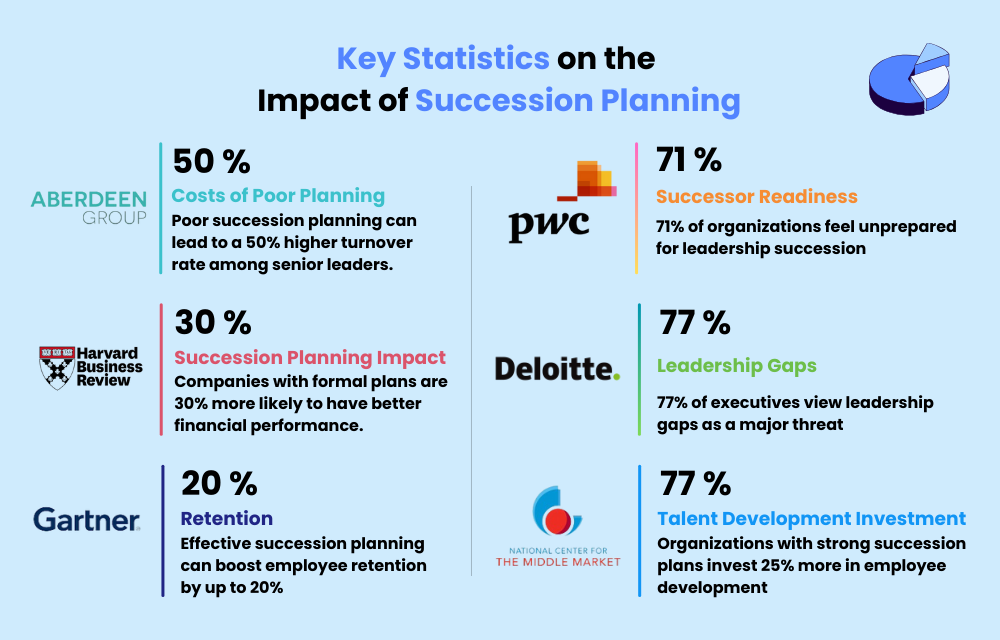
- Highly effective onboarding programs improve new-hire retention by 82% and productivity by over 70% within the first year.
- Structured approaches like mentorship, check-ins, and clear goals accelerate employee readiness. This early momentum fuels long-term performance through clarity and cultural assimilation.
- A strong onboarding experience delivers 62% higher new-hire performance, measured six months post-hire.
- Comprehensive orientation and tailored training boost early confidence and alignment with performance expectations. This early success significantly reduces time-to-competence.
- Organizations with documented succession plans are 1.9× more likely to have strong internal bench strength for critical roles.
- Goal clarity, performance metrics, and readiness frameworks support seamless role transitions and continuity. Internal candidates often outperform external hires due to institutional understanding.
- Companies with effective succession strategies reported 32% higher readiness for unplanned leadership changes.
- Planning ensures skills alignment, coverage, and ongoing leadership development. Preparedness reduces disruption and improves performance under uncertainty.
- Succession planning that includes performance data correlates with 24% faster promotion rates.
- Objective metrics identify high-potential talent earlier and more accurately. This clarity supports career development and internal mobility.
- Organizations that integrate onboarding data into performance systems report 18% faster time-to-productivity overall.
- Visibility into completion rates, goal progress, and skill acquisition drive early impact. Momentum builds quickly as performance elements align with culture and role demands.
- New hires with onboarding mentors are 23% more likely to remain beyond their first year. Mentorship complements formal onboarding, supporting social integration and performance.
- Firms actively promoting internal succession see 41% lower recruiter costs due to reduced external hiring.
- Companies tying onboarding metrics to long-term performance see 30% better retention of high performers.
- When succession candidates leverage goal-setting and feedback tools, 45% advance to leadership roles in under two years.
| Onboarding and Succession Metric | Performance Management Statistics Summary |
| New-hire retention improvement | +82% |
| Productivity boost in the first year | +70% |
| New-hire performance uplift | +62% |
| Succession resource readiness | 1.9× more likely |
| Leadership transition preparedness | +32% readiness |
| Promotion velocity via succession planning | +24% faster promotions |
| Increased time-to-productivity alignment | 18% faster as onboarding connects to performance |
| Mentorship effect on retention | +23% likelihood |
| Hiring cost reduction via internal promotion | to 41% recruiter cost |
| High-performer retention via active onboarding | +30% |
| Succession advancement success rate | +45% leadership placement within 2 years |
Performance Improvement Plans (PIP) and Underperformance Stats
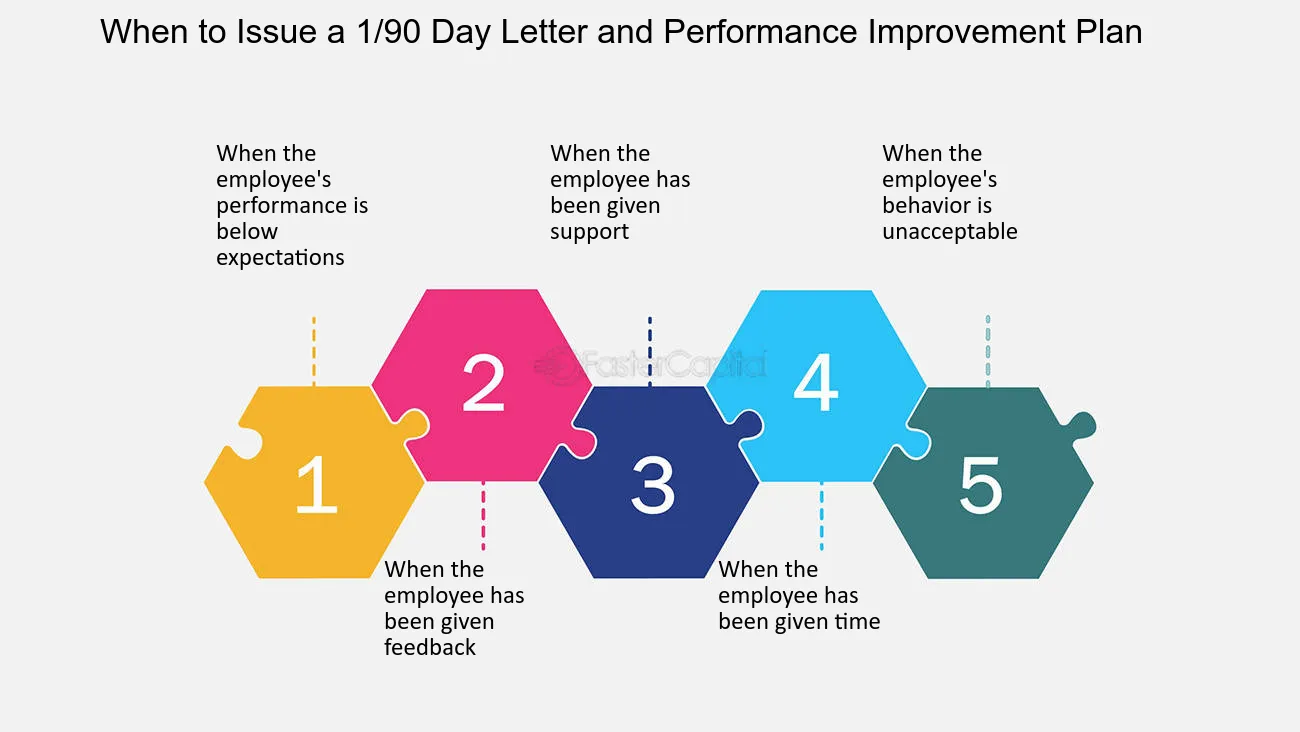
- Around 28% of companies use Performance Improvement Plans (PIPs) as a formal intervention for underperformance issues.
- PIPs set structured timelines, expectations, and metrics for improvement. Effective PIPs guide struggling employees to regain performance or exit gracefully.
- Only 38% of employees complete PIPs and meet improvement goals within three to six months. Lack of support or unclear expectations often leads to incomplete outcomes.
- 62% of PIP participants do not meet the outlined criteria and may transition out of the organization.
- Underperformers receiving consistent coaching show 23% greater improvement than those left on traditional PIPs.
- Formal PIP systems reduce turnover drag by 15 to 20%, compared to informal underperformance tracking.
- Teams with cumulative underperformance reviews see 12% higher rating accuracy in evaluations.
- If poorly managed, 45% of employees rate PIPs as demotivating or discipline-driven. The balance between accountability and support must be patient-focused.
- PIP-driven exits cost companies 25% less in severance when compared to unstructured departures.
- Using PIP participation as performance data contributes to 22% better hiring calibration over time.
- PIP cycles paired with frequent manager check-ins improve success rates by 30%. Ongoing feedback ensures real-time corrective actions and adaptive support.
| PIP Metric | Performance Management Statistics Summary |
| Companies using PIPs | 28% |
| Successful completion rate | 38% within 3 to 6 months |
| Rate of non-completion/exits | 62% |
| Performance improvement with coaching | +23% |
| Reduced turnover via structured PIPs | 15 to 20% |
| Evaluation accuracy increases with reviews | +12% |
| Negative perception of PIPs | 45% find PIPs demotivating |
| Cost savings on PIP exits | 25% less severance |
| Better hiring calibration via PIP data | +22% |
| Improvement with manager checkpoints | +30% |
Learning and Development (L&D) Effectiveness Statistics
- Companies investing $1,500+ per employee annually in training see 24% higher profit margins, driven by improved skills.
- L&D investment ties directly to competitive advantage and performance capability. Ongoing training closes skill gaps faster, accelerating goal achievement.
- High-performing firms spend 30% more on learning and development than average, correlating with growth outcomes. Greater investment indicates prioritization of upskilling for future readiness.
- Access to on-demand learning trips performance: employees report 44% faster skill uptake versus scheduled training.
- Training programs integrated with employee performance dashboards boost proficiency by 18%.
- Peer-led learning increases engagement with development by 59%, tapping into internal social learning.
- Only 40% of companies consider their development programs highly effective, suggesting room for refinement.
- Skills-based promotion pipelines tied to learning histories increase internal fill-rates by 48%.
Employee growth translates into succession-ready talent benches. L&D underpins performance-based career advancement. - Microlearning modules reduce knowledge retention loss by 50%, compared to traditional formats.
- Learning with clear application objectives mediates a 30% higher transfer of learning into practice.
- Organizations with strong L&D cultures outperform others by 2.3× in key performance metrics. Strategic alignment between learning and outcomes drives measurable results.
| L&D Metric | Performance Management Statistics Summary |
| Training spend vs. profit margins | $1.5k+ spend +24% margins |
| High-performing spend gap | +30% L&D budget vs average |
| Skill uptake speed via on-demand training | +44% faster |
| Dashboard-integrated training advantage | +18% proficiency increase |
| Peer-led learning engagement boost | +59% engagement |
| Perception of effective development programs | 40% rate highly effective |
| Internal fill rate increase via skill pipelines | +48% |
| Microlearning retention benefit | 50% knowledge loss |
| Transfer-to-practice uplift | +30% |
| Performance lift in strong L&D cultures | 2.3× better metrics |
Future Trends and Predictions for Performance Management Statistics
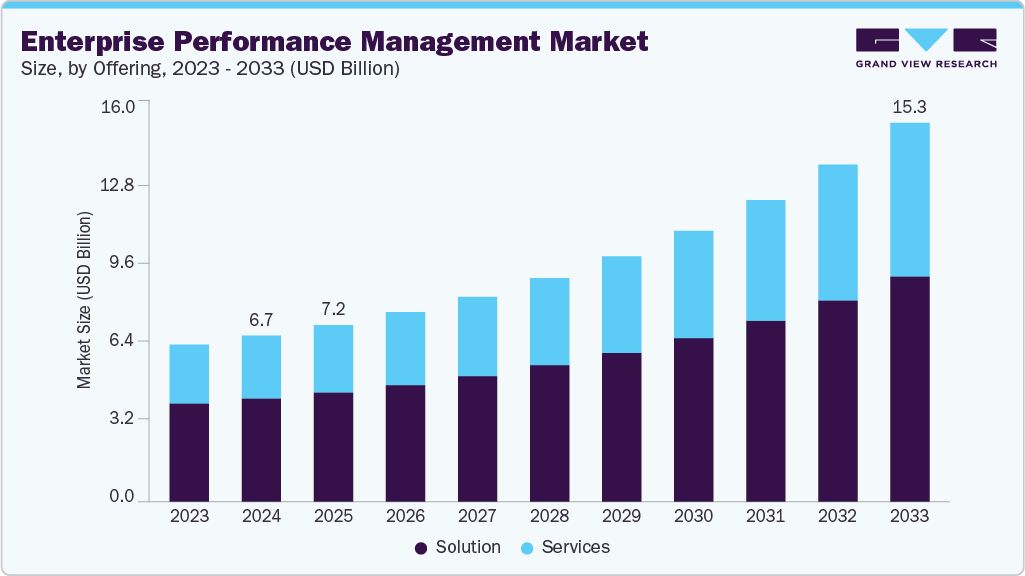
- By 2028, 48% of companies are projected to adopt continuous performance models over annual systems.
- AI adoption in performance management is expected to surpass 75% by 2030, offering unbiased insights and predictive analytics.
- Augmented Reality (AR)/Virtual Reality (VR) tools are anticipated in 15% of companies by 2027 for role simulation and skills testing.
- The usage of sentiment analytics in performance software will grow by 48% by 2026, enabling mood-based feedback loops.
- Blockchain-enabled credentialing is expected to be implemented by 22% of firms by 2028, ensuring transparency in achievement records. Immutable training and certification proofs build trust in promotions and mobility.
- Gamification of goals and feedback through apps will be used by 35% of HR teams by 2026 to boost engagement and motivation.
- Predictive performance systems will be used by 60% of enterprises by 2029 to anticipate skill gaps, development needs, and retention risks. Early identification leads to proactive coaching and better talent pipelines.
- Cross-functional peer review platforms are projected to be adopted by 44% of companies by 2027. Transparency in feedback fosters collective performance accountability.
- Use of mobile-first performance tools will rise to 70% by 2027, supporting real-time on-the-go feedback and check‑ins.
- By 2030, 80% of companies will tie ESG (Environmental, Social, Governance) metrics into performance reviews.
| Future Trend | Performance Management Statistics Forecast |
| Continuous model adoption | 48% of companies by 2028 |
| AI coverage in PM systems | 75% by 2030 |
| AR/VR tools usage | 15% by 2027 |
| Sentiment analytics integration | +48% by 2026 |
| Blockchain credentialing | 22% by 2028 |
| Gamified feedback systems | 35% by 2026 |
| Predictive performance analytics | 60% by 2029 |
| Cross-functional feedback | 44% by 2027 |
| Mobile-first PM tools adoption | 70% by 2027 |
| ESG metrics in reviews | 80% by 2030 |
Conclusion
So, after looking at these insights in performance management statistics, one thing is clear: performance in the workplace isn’t just a matter of opinion anymore; it’s backed by data. Whether it’s how often feedback is given, how engaged your employees feel, or how AI is helping modern workplaces, every number tells a story. And that story is pointing toward a future where performance is more personalized, more transparent, and more results-driven than ever before.
If you’re in HR, a manager, or even just curious about how teams succeed today, these stats give you a solid foundation. They highlight what’s working, where companies are falling short, and what steps can lead to better growth, retention, and results. The role of performance management has expanded, and these numbers help us stay ahead of the curve.
At the end of the day, performance isn’t just about goals on paper; it’s about real people doing real work. And when you understand the data, you can start managing performance in a way that makes a difference. That’s the real takeaway from all these performance management statistics. Thanks for staying up till this very end.
Sources
FAQ.
Key numbers include: 39% higher talent attraction, 44% better retention, and companies doing continuous feedback outperforming others by 24 to 50%. These figures show why timely feedback and goal alignment matter.
About 90% of performance reviews are considered ineffective, with 51% of workers calling their annual reviews inaccurate.
Managers spend around 210 hours per year per team on performance review activities, a large time investment tied to outdated annual systems.
Over 85% of Fortune 500 companies use 360-degree feedback, which typically drives around a 10% improvement in self-awareness and performance.
Continuous approaches link to 3× higher engagement, and companies that adopt them see 39% better talent attraction and 44% stronger retention.
95% of managers are dissatisfied with traditional performance systems; 59% of employees say they have no impact on performance.
Yes, Betterworks reports tools increase engagement rates by 11%, belonging by 62%, and employee development by 96%.

Joseph D'Souza founded Sci-Tech Today as a personal passion project to share statistics, expert analysis, product reviews, and experiences with tech gadgets. Over time, it evolved into a full-scale tech blog specializing in core science and technology. Founded in 2004 by Joseph D’Souza, Sci-Tech Today has become a leading voice in the realms of science and technology. This platform is dedicated to delivering in-depth, well-researched statistics, facts, charts, and graphs that industry experts rigorously verify. The aim is to illuminate the complexities of technological innovations and scientific discoveries through clear and comprehensive information.


